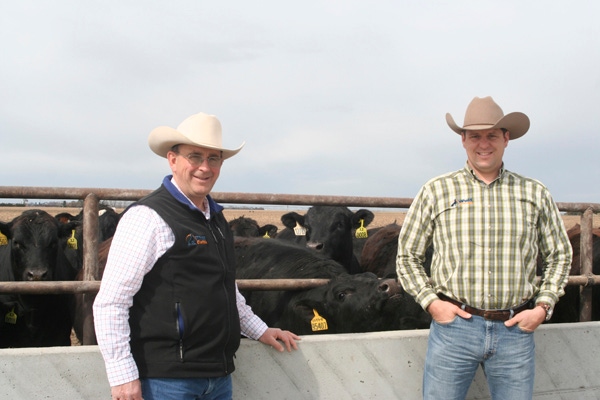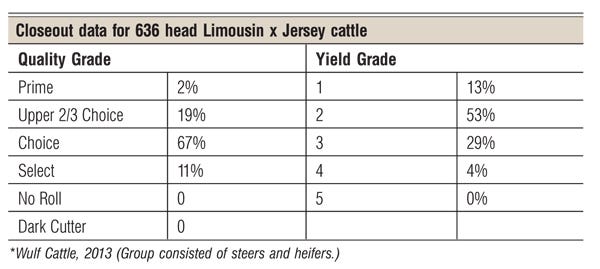A novel partnership between a cattleman and a dairyman develops a way to add value to both industries.
July 26, 2013

Wulf Cattle has been a well-known name in the beef business for more than 50 years. In fact, its founders, the late Leonard and Violet Wulf, Morris, MN, put the Limousin breed of cattle on the map.
Ahead of his time in the cattle-feeding business, Leonard focused on producing “genetics right for the rail.” Feeding thousands of Limousin-influenced cattle and creating a feeder calf procurement and buyback program of Wulf-sired genetics, he knew the value of red-meat yield. Leonard often said, “We were cattle feeders before we were cattle breeders.” But anyone in the industry knew he was very good at both.
Wulf Cattle isn’t resting on its past success. The firm recently celebrated its 25th anniversary bull sale. And the legacy lives on in the next generation under the direction of son Jerry, who is charting a new course still focused on Limousin genetics, but with a new twist.
Partnering for opportunity

Jerry Wulf, left, and Adam Zeltwanger, both with Wulf Cattle of Morris, MN, are part of a novel Limousin x Jersey cattle venture with River View LLP and Genex Cooperative that is helping to meet the specific needs of both the beef and dairy sectors.
In 2012, Jerry Wulf, president of Wulf Cattle, widened the scope of the operation by forming a partnership with Riverview LLP., a neighboring dairy operation. Riverview, whose CEO Gary Fehr is Wulf’s second cousin, is one of the largest dairy operations in Minnesota and South Dakota, milking over 45,000 cows — half of which are Jersey bloodlines.
The partnership is creating new enthusiasm for both the dairy and beef industries, yet it remains true to Wulf Cattle’s objectives. Two feedyards and a cow-calf ranch in north-central Nebraska were also added to the business during the merger.
A couple of years ago, Wulf and Fehr put their heads together and realized they had unique resources at their fingertips capable of moving the beef industry toward a new paradigm. But they would have to back up their hunch with trials and experiments to document their idea. The idea was to add value to the dairy industry while impacting the beef industry, especially at a time when beef cow numbers are the lowest in 50 years.
With the arrival and adoption of sexed semen technology, the dairy industry’s replacement female market has been saturated with top-producing cows and replacements. Sexed semen allows dairy producers to continue to fine-tune genetics to get the most pounds of milk/cow/day for the marketplace.
The focus on genetics and enhanced technologies was already allowing the industry to produce milk quantities that meet consumer demands. Yet, could the traditional moneymaker on a dairy operation — the dairy cow — bring in extra income, essentially enhancing profitability and value?
The Jersey bull/steer calf is of little value to the dairy industry; he’s not highly regarded by the feedlot industry, as Jerseys tend to be inefficient feed converters with overall low red-meat yield. But Wulf was aware that Jersey cattle boasted superior meat quality with tenderness and marbling.
That’s where the genetics of Wulf Cattle come into play. If you ask Wulf why he decided to test the Limousin x Jersey, he’ll answer, “Why not?” He says the value of muscling and feed efficiency that Limousin brings as a terminal cross is unmatched, along with the documented lowest birth weight of the continental breeds, according to U.S. Meat Animal Research Center data. “With such opposites in type — beef and dairy — we’re truly maximizing heterosis,” he adds.
The end goal is to make a dairy steer into a beef steer, adding tremendous value to the initial dairy bull calf, enhancing the income ability of the milk-producing cow and creating a carcass that contributes to the beef industry.
Testing the experiment
With the average size of a Jersey cow being about 1,000 lbs., calving ease and birth weight had to be considered and tested. Trials began in 2010 with calving-ease Wulf Limousin bulls. In 2,600 calvings, 98.8% were unassisted and the average birth weight was 79.5 lbs. Early trials focused on Limousin bulls with a -2.5 birth weight (BW) EPD or lower; since then, trials have found the window can be opened to bulls with a +2.5 or lower BW EPD without encountering dystocia problems.
With confirmation that birth weight wasn’t an issue, the focus moved to the feeding stage, and how the Limousin x Jersey steers would stack up against the beef breeds. The first test group of Limousin x Jersey cattle (550 head) entered the backgrounding phase at 400 lbs., and the final feeding stage at 850 lbs. They were fed at one of Wulf’s feedyards for about 120 days.
Measurements for feed conversion, gain, USDA Quality Grade (QG) and USDA Yield Grade (YG) were taken. Carcass data from the first feed trials in 2012 exhibited a QG of 48% Choice or higher, and 92% YG 1s and 2s. The packer said just keep on bringing them, Wulf reports.

Earlier this year, an additional group of 636 head was harvested at an average 1,352 lbs. live weight, yielding an average carcass weight of 852 lbs., and average dressing percentage of 62.74%. Quality grade was overwhelmingly Choice, with 66% achieving YG 1 or 2 and average ribeye area of 14.3 in (see chart).
As of May 2013, an additional 3,000 head were on feed, with another 5,000 head due to be born at Riverview in the nine months to follow. Wulf Cattle has named the Limousin x Jersey cross “Beef Builders.”
Breeding to FeedingSM program
The initial results of this unique beef x dairy program caught the eye of Genex Cooperative Inc., Shawano, WI, which has formed a partnership with Wulf Cattle called Breeding to FeedingSM. The program consists of homozygous black Limousin and Lim-Flex® sires that are trait leaders for calving ease, ribeye area, growth and marbling. The bulls are marketed directly to dairies by Genex employees.
“Many dairies have created selective breeding programs, then breed their best females to sexed semen for herd replacements, and the bottom end to beef semen for a more valuable terminal cross,” says Amy te Plate-Church, national alliance manager for Genex.
The Limousin genetics are targeted to the Jersey cows, and Wulf’s have added Lim-Flex bulls to target dairies with Holstein genetics. “Utilizing the Angus genetics in the Lim-Flex fits best with the larger-framed Holstein cow,” Wulf says.
“Breeding to Feeding is a win-win for both the dairy producer and Wulf Cattle,” says Adam Zeltwanger, who oversees Wulf Cattle’s dairy sales program. Zeltwanger’s role is to work with Genex to identify the location of calves that fit the program.

“Once the calves are born, dairies follow a calf-care protocol to enhance the health and performance that will impact the future ability of that calf to successfully gain and grow in the feedyard,” Zeltwanger says.
Want more beef news? Subscribe now to Cow-Calf Weekly for the latest industry news every Friday.
Wulf Cattle manages the process from that point forward. The calf is purchased by Wulf Cattle from the dairy at a premium based on current Holstein bull calf market prices, which results in added income for the dairy. The calves are moved to a calf ranch; at 400 lbs., they go to a backgrounding yard. After an additional 450 lbs. of gain are added, the Beef Builder calves make their final move to the finishing stage at a Wulf Cattle feedlot in Nebraska or Minnesota.
Zeltwanger says this program offers great ease of mind to the dairy producers, because they know that calves not impacting their milking herd still have the ability to enhance their profitability.
“Successfully creating pull-through demand for our beef genetics depends on our ability to communicate with our customers and cooperatively make decisions to breed better beef,” Zeltwanger says. Genetics are selected to fit the system, fed to meet the industry needs, and match the demands by the packer. Creating the pull-through demand is what Wulf Cattle is striving for.
B. Lynn Gordon, PhD, is a freelance writer based in Sioux Falls, SD.
You might also like:
34 Infographics That Connect The Dots From Gate To Plate
Tour A Feedlot: Dean Cluck Feedyard
Wyoming Dairyman Beef Producer Will Serve As 2013 NCBA President
Commercial Cattleman Builds Back His Herd Using DNA Marker Technology
You May Also Like



